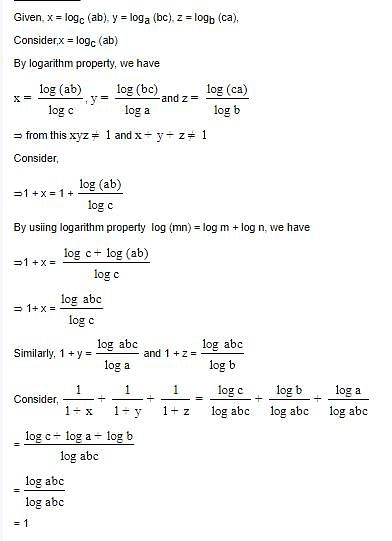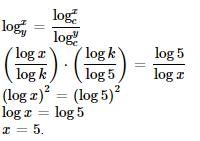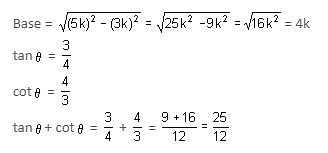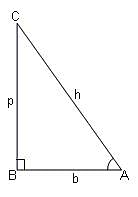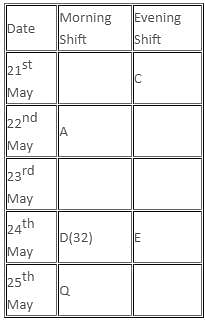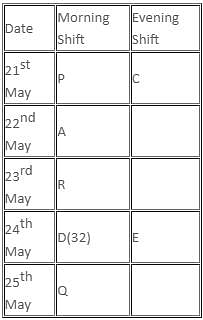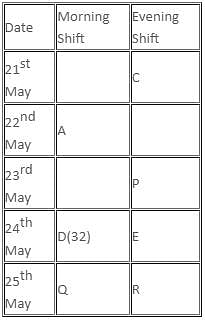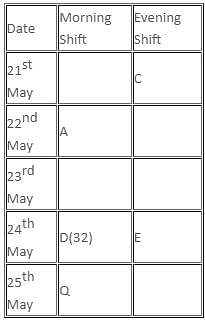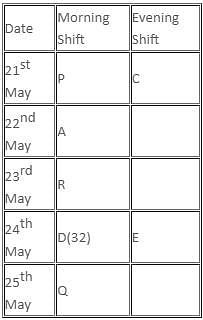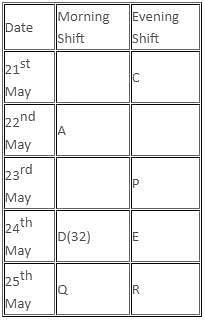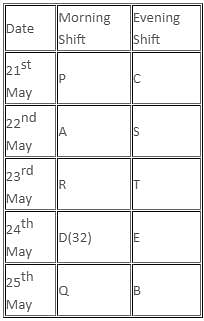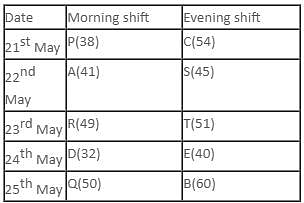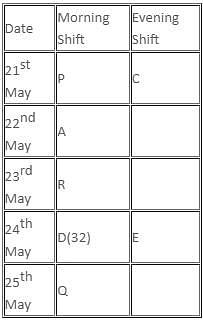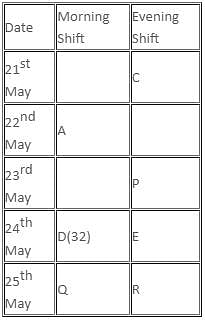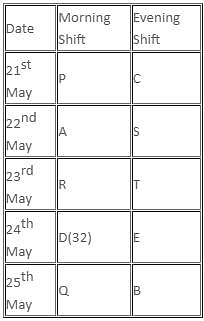CAT Practice Test: Month (May) - CAT MCQ
30 Questions MCQ Test - CAT Practice Test: Month (May)
If x = loga (bc), y = logb (ca) and z = logc (ab) when which of the following is equal to 1?
| 1 Crore+ students have signed up on EduRev. Have you? Download the App |
If logk x.log5 k = 1 k ≠ 1.k > 0, then x is equal to
Direction for questions 1 to 2 : Read passage below and solve the questions based on it.
Tn a horticultural show, a participant arranged a total of 1000 fruits of four types in a long straight line He first placed one apple, then two mangoes, three oranges, four custard apples, five apples, six mangoes, seven oranges, eight custard apples and so on (with apples followed by mangoes, oranges, custard apples in that order) uplo the 1000th fruit.
What was the 1000th fruit?
Direction for questions 1 to 2: Read passage below and solve the questions based on it.
In a horticultural show, a participant arranged a total of 1000 fruits of four types in a long straight line He first placed one apple, then two mangoes, three oranges, four custard apples, five apples, six mangoes, seven oranges, eight custard apples and so on (with apples followed by mangoes, oranges, custard apples in that order) uplo the 1000th fruit.
Q.
What was the position of the 100th Mango?
Find the number of non-negative integer solutions to the system of equations a + b + c + d + e = 20 and a + b + c = 5 is
In a test of 10 multiple choice questions of one correct answer, each having 4 alternative answers, then the number of ways to put ticks at random for the answers to all the questions is
Last year, there were 3 sections in the Catalyst, a mock CAT paper. Out of them 33 students cleared the cut-off in Section 1, 34 students cleared the cut-off in Section 2 and 32 cleared the cut-off in Section 3. 10 students cleared the cut-off in Section 1 and Section 2, 9 cleared the cut-off in Section 2 and Section 3, 8 cleared the cut-off in Section 1 and Section 3. The numberof people who cleared each section alone wasequal and was 21 for each section.
How many cleared only one of the three sections ?
Last year, there were 3 sections in the Catalyst, a mock CAT paper. Out of them 33 students cleared the cut-off in Section 1, 34 students cleared the cut-off in Section 2 and 32 cleared the cut-off in Section 3. 10 students cleared the cut-off in Section 1 and Section 2, 9 cleared the cut-off in Section 2 and Section 3, 8 cleared the cut-off in Section 1 and Section 3. The numberof people who cleared each section alone wasequal and was 21 for each section.
The ratio of the number of students clearing then cut-off in one or more of the sections to the number of students clearing the cutoff in Section 1 alone is?
Directions:
In a locality having 1500 households, 1000 watch Zee TV, 300 watch NDTV and 750 watch Star Plus.
Based on this information answer the questions that follow:
The minimum number of households watching both Zee TV and NDTV is:
Directions:
In a locality having 1500 households, 1000 watch Zee TV, 300 watch NDTV and 750 watch Star Plus.
Based on this information answer the questions that follow:
The maximum number of households who watch neither of the three channels is:
From a 60 m high building, the angles of depression of two cars on the opposite ends of the building are observed to be 60° and 30°. Find the distance between the cars, if the line joining them passes through the foot of the building.
In a right triangle ABC, right-angled at B, cot2 A = 9/16. What is the value of cos A?
Directions: Read the given passage and answer the question that follows.
A museum allowed groups of students from ten different schools A, B, C, D, E, P, Q, R, S and T to visit it in 10 different shifts over five days, from 21st May, 2018 to 25th May, 2018. There were two shifts (morning and evening) on each day and in a particular shift, only one school could visit. Each school came with a different number of students. The schools were instructed to bring at least 30 students, but not more than 60 students. None other than these ten schools visited the museum over these five days.
Over these five days, 210 students visited in the morning shift and 250 students visited in the evening shift. School D visited on 24th May with 32 students. The total number of students who visited in the two shifts on 23rd May was 100. Three schools visited the museum between schools D and A. School R visited the museum two days after school P, but in the same shift. School E visited the museum three days after school C, but in the same shift. School C visited the museum with 13 more students than school A, but on a different day. The sum of the numbers of students from schools E and B was the same as the sum of the numbers of students from schools R and T. School Q visited immediately after school E, but with 10 more students. The school that visited last came with 60 students. One school visited the museum between school S and school T. School T visited the museum after school S with 10 more students than school A. The number of students who came from school R was a square number. The numbers of students who visited from schools C and S were multiples of 9. The number of students who visited from school C was more than that from school S.
How many students from school P visited the museum?
Directions: Read the given passage and answer the question that follows.
A museum allowed groups of students from ten different schools A, B, C, D, E, P, Q, R, S and T to visit it in 10 different shifts over five days, from 21st May, 2018 to 25th May, 2018. There were two shifts (morning and evening) on each day and in a particular shift, only one school could visit. Each school came with a different number of students. The schools were instructed to bring at least 30 students, but not more than 60 students. None other than these ten schools visited the museum over these five days.
Over these five days, 210 students visited in the morning shift and 250 students visited in the evening shift. School D visited on 24th May with 32 students. The total number of students who visited in the two shifts on 23rd May was 100. Three schools visited the museum between schools D and A. School R visited the museum two days after school P, but in the same shift. School E visited the museum three days after school C, but in the same shift. School C visited the museum with 13 more students than school A, but on a different day. The sum of the numbers of students from schools E and B was the same as the sum of the numbers of students from schools R and T. School Q visited immediately after school E, but with 10 more students. The school that visited last came with 60 students. One school visited the museum between school S and school T. School T visited the museum after school S with 10 more students than school A. The number of students who came from school R was a square number. The numbers of students who visited from schools C and S were multiples of 9. The number of students who visited from school C was more than that from school S.
The students from which school visited the museum in the evening shift on 22nd May?
Directions: Read the given passage and answer the question that follows.
A museum allowed groups of students from ten different schools A, B, C, D, E, P, Q, R, S and T to visit it in 10 different shifts over five days, from 21st May, 2018 to 25th May, 2018. There were two shifts (morning and evening) on each day and in a particular shift, only one school could visit. Each school came with a different number of students. The schools were instructed to bring at least 30 students, but not more than 60 students. None other than these ten schools visited the museum over these five days.
Over these five days, 210 students visited in the morning shift and 250 students visited in the evening shift. School D visited on 24th May with 32 students. The total number of students who visited in the two shifts on 23rd May was 100. Three schools visited the museum between schools D and A. School R visited the museum two days after school P, but in the same shift. School E visited the museum three days after school C, but in the same shift. School C visited the museum with 13 more students than school A, but on a different day. The sum of the numbers of students from schools E and B was the same as the sum of the numbers of students from schools R and T. School Q visited immediately after school E, but with 10 more students. The school that visited last came with 60 students. One school visited the museum between school S and school T. School T visited the museum after school S with 10 more students than school A. The number of students who came from school R was a square number. The numbers of students who visited from schools C and S were multiples of 9. The number of students who visited from school C was more than that from school S.
How many more students were there in the group from school R than in the group from School S?
In a school with 800 students, 480 students are enrolled in Chemistry and 160 students are enrolled in both Chemistry and Physics. If the number of students who do not enrol in any of the subjects is equal to the one-seventh of the total number of students enrolled in Physics, then find how many students are not enrolled in either of them.
In a town of 10000 families, it was found that 40% families buy newspaper A, 20% families buy newspaper B and 10% families buy newspaper C, 5% families buy A and B, 3% buy B and C and 4% buy A and C. If 2% families buy all the three newspapers, then the number of families that buy none of these newspapers is
Directions: Read the following passage and answer the question that follows.
Today, the greatest crisis the country faces is increase in population. There are many problems which are being caused by population like health, unemployment, shortage of food, malnutrition, housing problem, illiteracy, ecological imbalance, etc. The country is outstripping China in population growth, adding the population of Australia almost every year and making sure that one person in every four is an Indian. The rapid increase in population has serious implications for the overall socio-economic development of the country. Various social customs and beliefs favour large families and impede the process of change for adoption of modern methods of birth control. What happens to our poverty curve, our standard of living, our per capita gross national product? Where would these additional millions be absorbed? Where will they work? Would they not boost the crime graph?
It is said that even if the entire 66 million of the unemployed do not take to crime, quite a large number may be tempted to do so. Cannot education come to their rescue? Surely not. Firstly, there are not enough teachers to meet the demand and the necessity to earn something to fill their own bellies and of their parents, makes education usually a low priority, in spite of facilities and incentives available to bring every child to school. This leads people from their school to their work location where they do not find much opportunity. Hence, they revert to crime.
Rapid population growth has also disturbed the ecological balance of nature. Water is everywhere but not a drop to drink. Hardly 69 per cent people have access to safe drinking water. Thousands died and lakhs were affected by cholera and gastroenteritis for want of safe drinking water in trans-Yamuna areas in Delhi. If the present ecological damage continues as a result of increasing population, one shudders to think of what is to follow.
Another major problem encountered is that the prices are going up and poverty is increasing. About 40% of the population in India is below the poverty line. Food reserves are diminishing. Essential goods are scarce. Land is being divided into smaller units. As a result, the standard of living is going down. Can we check these deteriorating conditions? Can we find answers anywhere else?
China has managed to bring down their population growth to 1.2% by enactment of law. In India, enactment of law for limiting family size is not feasible. Moreover, simply enacting a law won't make much difference, unless the law enforcing machinery, health workers and the masses join hands together. For national prosperity, we must have thorough planning. Our survival hangs in the balance. Strong human power must intervene in the sad state of affairs. This need not necessarily be the power of the government as we generally assume it to be but an effort of the collective.
Q. The standard of living is going down primarily because of
(I) poor governance
(II) increase in prices
(III) division of land into smaller units
Directions: Read the following passage and answer the question that follows.
Today, the greatest crisis the country faces is increase in population. There are many problems which are being caused by population like health, unemployment, shortage of food, malnutrition, housing problem, illiteracy, ecological imbalance, etc. The country is outstripping China in population growth, adding the population of Australia almost every year and making sure that one person in every four is an Indian. The rapid increase in population has serious implications for the overall socio-economic development of the country. Various social customs and beliefs favour large families and impede the process of change for adoption of modern methods of birth control. What happens to our poverty curve, our standard of living, our per capita gross national product? Where would these additional millions be absorbed? Where will they work? Would they not boost the crime graph?
It is said that even if the entire 66 million of the unemployed do not take to crime, quite a large number may be tempted to do so. Cannot education come to their rescue? Surely not. Firstly, there are not enough teachers to meet the demand and the necessity to earn something to fill their own bellies and of their parents, makes education usually a low priority, in spite of facilities and incentives available to bring every child to school. This leads people from their school to their work location where they do not find much opportunity. Hence, they revert to crime.
Rapid population growth has also disturbed the ecological balance of nature. Water is everywhere but not a drop to drink. Hardly 69 per cent people have access to safe drinking water. Thousands died and lakhs were affected by cholera and gastroenteritis for want of safe drinking water in trans-Yamuna areas in Delhi. If the present ecological damage continues as a result of increasing population, one shudders to think of what is to follow.
Another major problem encountered is that the prices are going up and poverty is increasing. About 40% of the population in India is below the poverty line. Food reserves are diminishing. Essential goods are scarce. Land is being divided into smaller units. As a result, the standard of living is going down. Can we check these deteriorating conditions? Can we find answers anywhere else?
China has managed to bring down their population growth to 1.2% by enactment of law. In India, enactment of law for limiting family size is not feasible. Moreover, simply enacting a law won't make much difference, unless the law enforcing machinery, health workers and the masses join hands together. For national prosperity, we must have thorough planning. Our survival hangs in the balance. Strong human power must intervene in the sad state of affairs. This need not necessarily be the power of the government as we generally assume it to be but an effort of the collective.
Q. According to the author, what is the relationship between the unemployment and the crime statistics?
Directions: The passage below IS followed by a question based on its content. Answer the question on the basis of what is stated or implied in the passage.
The categorization by literary historians can be to some extent a precarious venture. When Asian poets are discussed independently as a set, for example, the degree to which their work reveals the advancement of poetry in broad–spectrum should not be forgotten, or a misrepresentation of literary history may be the consequence. This prudence is predominantly pertinent in an appraisal of the divergence between Asian poets at the start century (1900–1909) and those of the generation of the 1920's. These dissimilarities include the intrepid and more candid vocalizations of the later generation and its methodological ingenuity. It should not be forgotten, though, that analogous differences also existed for parallel generations of British poets.
When poets of the 1910's and 1920's are considered collectively, however, the peculiarities that literary historians might make out between "traditional" and "experimental" would be of little consequence in a debate of Asian poets, although these remain supportive classifications for British poets of these decades. Positively differences can be noted between "traditional" Asian poets such as Tagore and Seth and "experimental" ones such as Chan and Qayuum. But Asian poets were not fighting over old or fresh styles; rather, one consummate Asian poet was ready to welcome another, without caring for his or her styles, for what weighed was racial pride.
But, in the 1920's, Asian poets deliberated over the issue whether they should deal with particularly racial themes. The questions were raised like whether they should only write about Asian experience for an Asian audience or whether such demands were restraining. It may be believed, though, that nearly all these poets wrote their finest poems when they spoke out of racial sentiment, race being, as Kim Sun rightly put it,
"Necessarily the thing the Asian poet knows best".
At the start of the century, by comparison, most Asian poets generally wrote in the conformist manner of the age and articulated noble, if ambiguous, sentiments in their poetry. These poets were not extraordinarily gifted, though Rosh Jannah and J. Mitra may be segregated from the group. They decided not to write in vernacular, which as Stuart Bergmann has suggested, "Intended a refutation of stereotypes of Asian life," and they declined to write solely about racial issues. This denial had both a positive and negative results. As Bergmann observes, "Usefully persisted that Asian poets should not be cramped to issues of race, these poets made error .... They declined to introspect and write". These are vital perspicacities, but one must accentuate that this refusal to look within was also characteristic of most British poets of the time. They, too, often ignored their own familiarity and consequently fashioned some very ordinary poems about indistinct topics, such as the tranquility of nature.
Q. According to the passage, most turn-of-the century Asian poets generally did which of the following?
Directions: Select the word/phrase most similar in meaning to the word given in bold letters.
ARDUOUS
Directions: Select the word that most closely defines the word given in bold letters.
ACCESS
Directions: Select the word/phrase that is antonymous to the word given in bold letters.
AMORTIZE
Directions: Select the word/phrase that most closely defines the word given in bold letters.
BANAL
Directions: Select the word/phrase that is antonymous to the word given in bold letters.
APPROBATION
Directions: The sentence below has been divided into four parts. Identify the part having an error. If no part has an error, mark (5).
(1) Without hardly (2) any delay, (3) the government machinery began to provide (4) succour to quake victims. (5) No error


